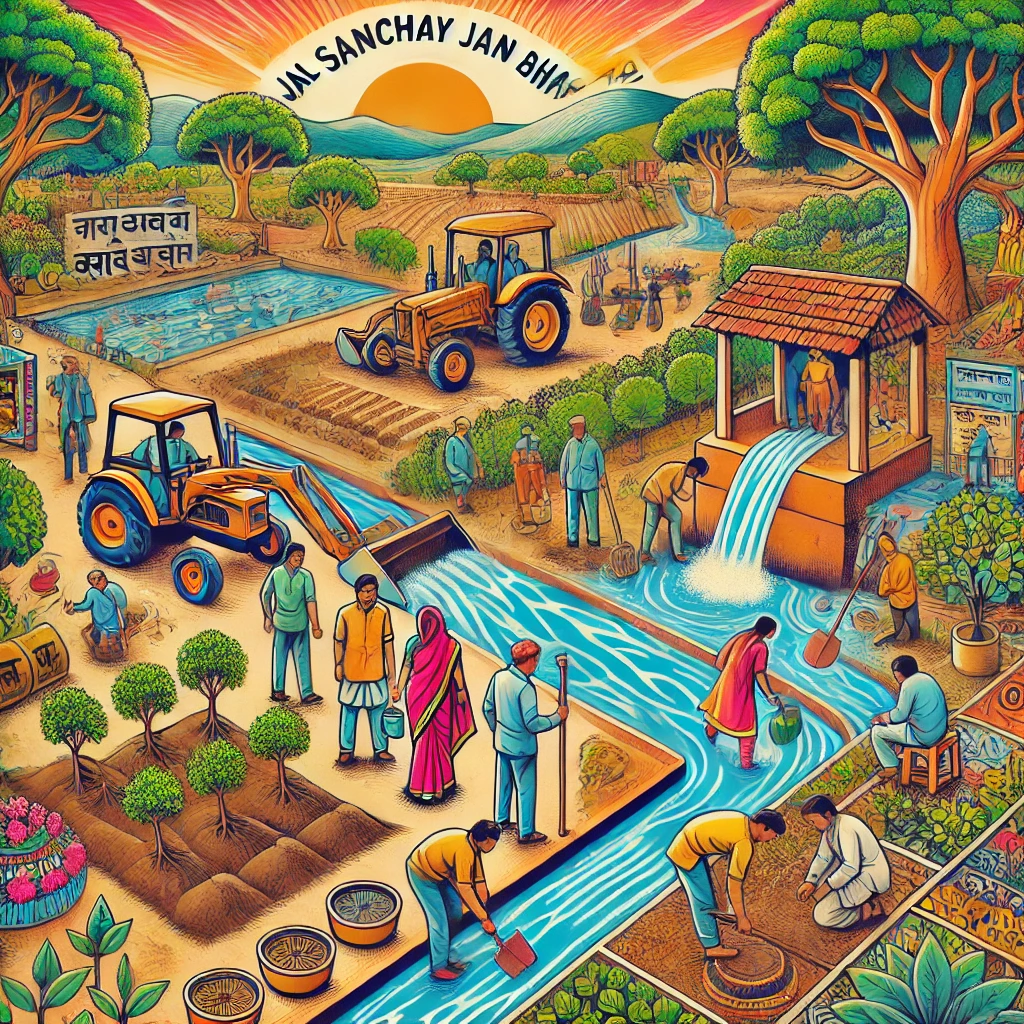
Why in News?
Recently, the Jal Sanchay Jan Bhagidari (Water Conservation through People’s Participation) initiative was launched from Surat, Gujarat. This program emphasizes community involvement in water conservation efforts, aiming to address the pressing issue of water scarcity and promote sustainable water management practices across the state.
About Jal Sanchay Jan Bhagidari Initiative
Objective
- Community Partnership and Ownership: The initiative seeks to conserve water by fostering strong community partnerships. It emphasizes ownership of water resources by local communities, ensuring sustainable management.
Key Features
- Rainwater Harvesting Structures: Plans to construct around 24,800 rainwater harvesting structures through active community participation.
- Sustainable Water Management: Aims to ensure long-term water sustainability by utilizing traditional and modern water conservation methods.
- Building on Previous Success: Based on the successful Jal Sanchay initiative by the Gujarat Government, which mobilized citizens, local bodies, industries, and other stakeholders for water conservation.
Implementing Agency
- Ministry of Jal Shakti: The initiative falls under the purview of the Ministry of Jal Shakti, Government of India, which is responsible for water resource management and sanitation.
Importance of Community Participation in Water Conservation
Community participation is crucial for the success of water conservation initiatives due to the following reasons:
- Localized Solutions: Communities understand their local water issues better and can devise effective solutions.
- Sustainability: Community ownership ensures maintenance and sustainability of water structures.
- Awareness and Education: Involving communities raises awareness about water scarcity and conservation techniques.
- Empowerment: Empowers local populations, especially women, to take charge of their resources.
Examples of Community Participation in Water Conservation in India
1. Local Jal Samitis under Jal Jeevan Mission
- Description: Formation of village-level water committees.
- Features:
- At least 50% participation of local village women.
- Responsible for operation, maintenance, and management of water supply infrastructure.
2. Neeru-Chettu (Andhra Pradesh)
- Objective: Rejuvenate and revitalize natural water resources.
- Activities:
- Watershed development.
- Construction of check dams, percolation tanks.
- Afforestation efforts.
3. Jal Jeevan Hariyali (Bihar)
- Aim: Identification, restoration, and renovation of all public water storage structures.
- Key Components:
- Rainwater harvesting.
- Promotion of solar energy.
- Plantation drives.
4. Jal Hi Jeevan Hai (Haryana)
- Goal: Encourage crop diversification to conserve water.
- Strategies:
- Promote cultivation of less water-intensive crops like Maize and Arhar (Pigeon Pea).
- Provide incentives to farmers switching from water-intensive crops like paddy.
5. Mission Kakatiya (Telangana)
- Purpose: Restoration of minor irrigation sources.
- Achievements:
- Reclamation of water tanks.
- Improved groundwater levels.
- Enhanced agricultural productivity.
Traditional Water Storage Systems in India
India has a rich history of traditional water conservation methods adapted to local conditions:
- Jal Mandir (Gujarat): Temple tanks used for religious and community purposes.
- Khatri, Kuhl (Himachal Pradesh): Gravity-based irrigation channels.
- Zabo (Nagaland): Integrated farming system combining forestry, agriculture, and animal husbandry with water harvesting.
- Eri, Ooranis (Tamil Nadu): Earthen tanks and ponds for irrigation and domestic use.
- Dongs (Assam): Floodwater harvesting systems.
- Katas, Bandhas (Odisha and Madhya Pradesh): Man-made ponds for irrigation.
- Paar, Johad (Rajasthan): Community-owned earthen embankments to capture and store rainwater.
- Pat (Madhya Pradesh): Underground canals tapping stream water for irrigation.
Other Government Initiatives Fostering Community Participation in Water Conservation
1. Jal Jeevan Mission (JJM)
- Launched: 2019.
- Objective: Provide functional household tap connections to every rural household by 2024.
- Community Involvement:
- Decentralized, demand-driven approach.
- Village Water and Sanitation Committees (VWSCs) manage water supply systems.
- Emphasis on community-managed programs for maintenance.
2. Prime Minister Krishi Sinchayee Yojana (PMKSY)
An umbrella scheme with various components aiming to enhance water use efficiency and expand irrigation coverage.
a. Har Khet Ko Pani
- Aim: Ensure water reaches every farm.
- Features:
- Development of new water sources.
- Repair and restoration of existing water bodies.
- Promotion of micro-irrigation.
b. Watershed Development
- Objective: Utilize rainwater for irrigation through watershed management.
- Activities:
- Construction of water harvesting structures like dams, ponds, check dams.
- Soil and moisture conservation.
c. Per Drop More Crop
- Focus: Increase water use efficiency in agriculture.
- Strategies:
- Adoption of precision irrigation devices like drip and sprinkler systems.
- Encourage farmers to use modern irrigation methods to save water.
3. Atal Bhujal Yojana
- Launched: 2019.
- Objective: Sustainable management of groundwater resources.
- Coverage: Implemented in over-exploited and water-stressed areas in Gujarat, Haryana, Karnataka, Madhya Pradesh, Maharashtra, Rajasthan, and Uttar Pradesh.
- Community Participation:
- Involvement of local communities in groundwater management.
- Preparation of water security plans at the Gram Panchayat level.
Significance of Jal Sanchay Jan Bhagidari Initiative
- Addressing Water Scarcity: With increasing demand and climatic variations, water conservation is crucial for sustainability.
- Promoting Sustainable Practices: Encourages the adoption of rainwater harvesting and replenishment of groundwater.
- Empowering Communities: Fosters a sense of responsibility and ownership among citizens.
- Replication Potential: Successful implementation can serve as a model for other states.
Relevance for UPSC Examination
General Studies Paper I
- Indian Geography: Resource distribution, including water resources.
- Society: Role of women and community in development.
General Studies Paper II
- Governance: Government policies and interventions for development.
- Constitutional Mechanisms: Decentralization and Panchayati Raj Institutions.
General Studies Paper III
- Conservation: Environmental conservation, sustainable development.
- Agriculture: Water resource management in agriculture.
Essay Paper
- Topics on water conservation, community participation, and sustainable development.
Conclusion
The Jal Sanchay Jan Bhagidari initiative is a significant step towards sustainable water management in India. By emphasizing community participation, it not only addresses the immediate need for water conservation but also empowers local communities to take charge of their resources. The integration of traditional wisdom with modern techniques can pave the way for a water-secure future.
